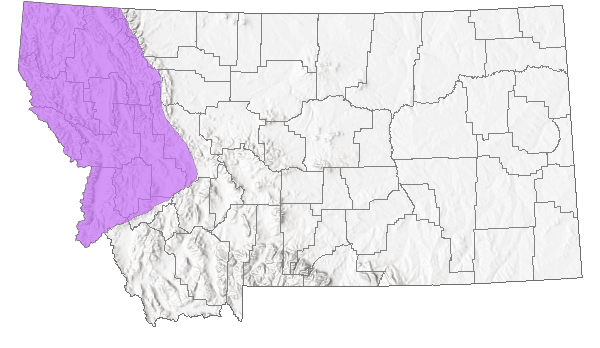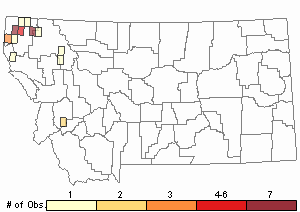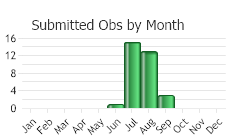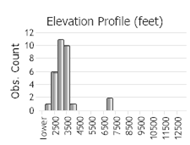View in other NatureServe Network Field Guides
NatureServe
Montana
Utah
Wyoming
Idaho
Wisconsin
British Columbia
South Carolina
Yukon
California
New York
Stalked Moonwort - Botrychium pedunculosum
State Rank Reason (see State Rank above)
This moonwort species is known to occur in western Montana from approximately a dozen extant occurrences, almost all of which are on National Forest lands. Many occurrences are small in size and occupy western redcedar forests and roadsides or other similarly open or disturbed habitats. Several site records are based upon specimen collections with no available population data; almost all other sites have population counts with <10 plants observed. One site has been observed with >100 plants. Sites could be negatively impacted by timber harvesting or road-related activities.
- Details on Status Ranking and Review
Population Size
CommentVery small population numbers documnted.
Range Extent
Score1 - Peripheral, Disjunct or Sporadic Distribution in MT: Widespread species that is peripheral, disjunct or sporadically distributed within MT such that it occurs in <5% of the state (<7,500 sq. miles or the combined area of Beaverhead and Ravalli Counties) or is restricted to 4-5 sub-basins.
CommentSparsely distributed in northwest Montana
Number of Populations
CommentOnly a few populations documented
Environmental Specificity
Score0 - Low: Species is a generalist that occurs in a variety of habitats and/or is tolerant of disturbed or degraded habitats (C -Values of 1-4).
CommentNot restricted to a rare or specialized habitat.
Trends
Score0 - Stable or Increasing: Population size, range, and/or available habitat stable, increasing or fluctuating in the recent past (approximately 30 years).
CommentTrends data are lacking though probably stable with fluctuating numbers.
Threats
Score0 - Low: Impacts, if any, to the species are expected to be minor or insignificant (affecting <10% of populations) in severity, scope and immediacy.
CommentThreats to the species appear to be minimal.
Intrinsic Vulnerability
Score1 - Moderate Vulnerability: Specific biological attributes, unusual life history characteristics or limited reproductive potential makes the species susceptible to extirpation from stochastic events or other adverse impacts to its habitat and slow to recover.
General Description
Stalked moonwort is a perennial with a single above ground frond up to 20 cm tall. It is divided into two segments that share a common stalk. The lower common stalk is usually reddish brown and the upper part of the plant is a dull green. The mostly sterile segment is conspicuously stalked and once to twice pinnatifid with up to five pairs of primary pinnae. The pinnae have irregular lobes and vary from pinnatifid to bifid to narrowly fan shaped and the lower ones often bear sporangia. The fertile segment is longer than the sterile segment and bears grape-like sporangia that contain thousands of spores; larger plants usually have two large ascending lateral branches.
Phenology
Fronds mature in mid-July to September.
Diagnostic Characteristics
Botrychium pedunculosum is most similar to B. pinnatum and B. hesperium, which may also have reddish common stalks and pinnatifid pinnae. It differs from B. pinnatum by having dull green vs. bright green color and leathery vs. papery texture, and differs from B. hesperium by having the lowest pinnae pair about the same size as, rather than conspicuously larger than, the adjacent pair. It differs from both by having a long stalked sterile frond segment. Positive identification of moonworts depends on the use of technical keys and on comparison with silhouette outlines of verified specimens, often complicated by morphological variation within and between populations, and the presence of several species growing together at the same site.
Species Range
Montana Range
Range Descriptions

 Native
Native
Range Comments
In MT in Lincoln, Flathead, Sanders, and Granite counties; BC and AB south through eastern WA, ID, western MT, with disjunct populations in AK, NE QC and Labrador, and east-central CA (Donald Farrar, Iowa State University, unpublished ms.)
Observations in Montana Natural Heritage Program Database
Number of Observations: 32
(Click on the following maps and charts to see full sized version)
Map Help and Descriptions
Relative Density

Recency



 (Observations spanning multiple months or years are excluded from time charts)
(Observations spanning multiple months or years are excluded from time charts)
Habitat
Various mesic sites from valley bottoms to the montane zone. The most common habitats are western redcedar bottomlands. Common moonwort associates include B. minganense, B. lanceolatum and B. montanum. Other moonworts reported at B. pedunculosum sites include B. paradoxum, B. ascendens, B. pinnatum, B. pallidum, B. lunaria, B. hesperium, B. simplex, B. crenulatum and B. michiganense.
Ecological Systems Associated with this Species
References
- Additional ReferencesLegend:
 View Online Publication
View Online Publication
Do you know of a citation we're missing? Farrar, Donald. 2011. Moonwort (Botrychium) Systematics. Ada Hayden Herbarium. Iowa State University.
Farrar, Donald. 2011. Moonwort (Botrychium) Systematics. Ada Hayden Herbarium. Iowa State University. Lesica, P., M.T. Lavin, and P.F. Stickney. 2012. Manual of Montana Vascular Plants. Fort Worth, TX: BRIT Press. viii + 771 p.
Lesica, P., M.T. Lavin, and P.F. Stickney. 2012. Manual of Montana Vascular Plants. Fort Worth, TX: BRIT Press. viii + 771 p. Lesica, P., M.T. Lavin, and P.F. Stickney. 2022. Manual of Montana Vascular Plants, Second Edition. Fort Worth, TX: BRIT Press. viii + 779 p.
Lesica, P., M.T. Lavin, and P.F. Stickney. 2022. Manual of Montana Vascular Plants, Second Edition. Fort Worth, TX: BRIT Press. viii + 779 p. Vanderhorst, J.P. 1997. Conservation assessment of sensitive moonworts (Botrychium subgenus Botrychium) on the Kootenai National Forest. Unpublished report. Montana Natural Heritage Program, Helena, MT 82 pp. plus appendices.
Vanderhorst, J.P. 1997. Conservation assessment of sensitive moonworts (Botrychium subgenus Botrychium) on the Kootenai National Forest. Unpublished report. Montana Natural Heritage Program, Helena, MT 82 pp. plus appendices. Wagner, W. and F. Wagner. 1986. Three New Species of Moonworts (Botrychium Subgenus Botrychium) Endemic in Western North America. American Fern Journal 76 (2):3347
Wagner, W. and F. Wagner. 1986. Three New Species of Moonworts (Botrychium Subgenus Botrychium) Endemic in Western North America. American Fern Journal 76 (2):3347 Wagner, W. H. and F. S. Wagner. 1993. Ophioglossaceae. In: Flora of North America Editorial Committee, eds. 1993. Flora of North America North of Mexico. 3+ vols. New York and Oxford. Vol. 2, pp. 85-106.
Wagner, W. H. and F. S. Wagner. 1993. Ophioglossaceae. In: Flora of North America Editorial Committee, eds. 1993. Flora of North America North of Mexico. 3+ vols. New York and Oxford. Vol. 2, pp. 85-106. Zika, P. F. 1994. A draft management plan for the moonworts Botrychium ascendens, B. crenulatum, B. paradoxum, and B. pedunculosum in the Wallowa-Whitman, Umatilla, and Ochoco National Forests. Unpublished report. Oregon Natural Heritage Program, Portland, OR. 41 pages plus figures, tables and appendices.
Zika, P. F. 1994. A draft management plan for the moonworts Botrychium ascendens, B. crenulatum, B. paradoxum, and B. pedunculosum in the Wallowa-Whitman, Umatilla, and Ochoco National Forests. Unpublished report. Oregon Natural Heritage Program, Portland, OR. 41 pages plus figures, tables and appendices.
- Web Search Engines for Articles on "Stalked Moonwort"





